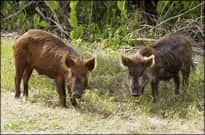Felsenthal NWR Feral Hogs Infected with Swine Brucellosis and Pseudorabies in Arkansas
Arkansas Game and Fish Commission 12.13.12

Felsenthal National Wildlife Refuge officials, in cooperation with officials from the U.S. Department of Agriculture’s Wildlife Services Disease Program, collected biological samples from 46 feral swine during spring and summer 2012. Of the 46 pigs tested, 10 tested positive for swine brucellosis and 16 tested positive for pseudorabies.
Refuge officials encourage the hunting public to educate themselves on the diseases and take the appropriate precautions when handling feral hogs. We definitely don’t want these findings to deter hunters from harvesting feral hogs on the refuge, says refuge biologist Rick Eastridge. “Utilizing the proper precautions while handling feral hogs is the best safety measure,” he said.
Feral hogs may be killed on the refuge by hunters incidental to any daytime refuge hunt and with legal hunting equipment and ammunition allowed for that hunt. Hunters are not allowed to pursue or kill feral hogs with the use of dogs. Live hogs may not be transported or possessed on the refuge.
Facts about Swine Brucellosis:
Swine brucellosis is transmissible to humans. Humans with this disease typically have flu-like symptoms including intermittent fever, chills, sweating, headaches, muscle and joint soreness, and weakness. Although few human fatalities occur as a result of infection, the disease is often chronic and debilitating. Hunters should be advised to wear rubber gloves and to wash with soap and hot water as soon as possible after handling a feral pig carcass and to ensure that the meat is cooked thoroughly before consumption.
Swine brucellosis is caused by a bacterium and should not be confused with bovine brucellosis, or the disease found in goats and dogs caused by other Brucella bacteria. Swine are considered the natural host for swine brucellosis and the disease can be harbored in swine without signs of illness. Swine brucellosis is primarily a reproductive tract disease, so when field dressing hogs, hunters should be especially careful when handling the reproductive tracts of either sex of pig. Swine brucellosis has not been documented to occur in any wildlife species found in the Southeastern U.S., therefore native species should not be affected.
Facts about Pseudorabies:
Despite its name, pseudorabies is caused by a herpes virus and is not related to rabies and does not affect humans. Pseudorabies is a fatal disease to farm animals such as cattle, sheep, and goats, and in dogs and cats. Wildlife including raccoons, skunks, foxes, opossums, and small rodents, also can be fatally infected. In non-swine hosts, the pseudorabies virus attacks the central nervous system and results in loss of appetite, depression, staggering, spasms, convulsions, paralysis and death. Self-mutilation by persistent scratching, biting, or rubbing frequently occurs and has caused pseudorabies to be called “mad itch”. Although humans are not directly at risk, hunters should know that their dogs could become fatally infected through exposure to feral swine that harbor pseudorabies.
Psudorabies is a concern to domestic swine producers because it can weaken domestic pigs leaving them susceptible to other problems, and causes abortions and stillbirths in domestic swine. In feral swine, pseudorabies infection varies from in apparent to fatal depending primarily on the age of the pig. Young pigs are most severely affected and a high death rate occurs in pigs less than four weeks old. Adult swine rarely die from pseudorabies infection and can carry the disease while appearing normal and healthy.
While visiting the Felsenthal National Wildlife Refuge, tune your radio to 1620 AM or follow on Facebook at South Arkansas Refuge Complex for refuge information. For additional information or to speak with staff, contact Felsenthal National Wildlife Refuge at 870-364-3167. There is additional information on the AGFC website at http://www.agfc.com/species/Pages/SpeciesNuisanceWildlifeResources.aspx.

